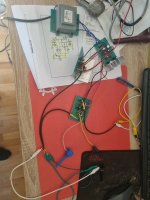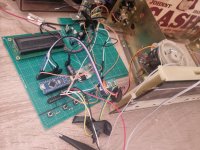If you are up to the challenge, the high pass could be made far more effective by using a steeper filter at a strategically placed frequency. It’s the way they do things in pro audio to get the most out of a speaker possible. It’s relatively easy using technology you are already using. Look up “4th order Sallen-Key filter” to get an idea what I’m referring to. A steeper filter will take out more of the very low frequency the speaker can’t respond to, leaving even more power for those it can. It’s especially useful if you are boosting the entire bottom end, which normally adds more 30,40, 50 Hz content than a little 3x5 speaker is really happy with. And the amount of air moved by it is entirely inaudible anyway. You DO want the large boost centered between 80 and 150 just to make male vocals and musical fundamentals sound right on a little speaker. The little one cap one resistor passive filter does the same thing, just not to the same degree of effectiveness.
Yes, I would like that. I`m listening to it and I feel it could loose some low boost above 250hz. But I think that steep hp filter would help with that, as it would add more lower frequencies.
I`m also learning music production in DAW, so I have a bit of feel for EQ and know what to expect. (And a big difference with using steep slope)
I changed gain resistor on preamp to 4.7k and it is alot better. I think that I will go even higher, because it is clipping at 50hz sine with low boost all the way up.
But will see later, also I will probably lower the gain on the amp itself.
10k volume pot is quite sensitive right now, so I will see how it will be once I set the gains and replace with higher resistance pot if needed.
PS: Grounds are now seperated, and I added that 10k sesistor to 1k -to get 900ohm to restore the band parametres.
Do you see any problem with mounting 1 preamp board above another, about 5cm apart? I will propably start to run short on space.
Also I might add a tweeter, I was thinking of making a plate to mount it infront of the speaker (like on coaxial speaker), or maybee glue a funnel around the dustcap (last idea is just a thought, would need to explore this option more).
EDIT: When I test the sound I like to listen to a different music, different styles & eras... I had just move up to 90s dance music and bass is clipping like crazy. It`s not the preamp (lowering input signal doesn`t help). Either amp or speaker, very dirty bass (Probably too much boost on top of bass heavy signal?).
I will try with different speaker, it this won`t help, I will wait to see if it will get better with HP filter...
I`m also learning music production in DAW, so I have a bit of feel for EQ and know what to expect. (And a big difference with using steep slope)
I changed gain resistor on preamp to 4.7k and it is alot better. I think that I will go even higher, because it is clipping at 50hz sine with low boost all the way up.
But will see later, also I will probably lower the gain on the amp itself.
10k volume pot is quite sensitive right now, so I will see how it will be once I set the gains and replace with higher resistance pot if needed.
PS: Grounds are now seperated, and I added that 10k sesistor to 1k -to get 900ohm to restore the band parametres.
Do you see any problem with mounting 1 preamp board above another, about 5cm apart? I will propably start to run short on space.
Also I might add a tweeter, I was thinking of making a plate to mount it infront of the speaker (like on coaxial speaker), or maybee glue a funnel around the dustcap (last idea is just a thought, would need to explore this option more).
EDIT: When I test the sound I like to listen to a different music, different styles & eras... I had just move up to 90s dance music and bass is clipping like crazy. It`s not the preamp (lowering input signal doesn`t help). Either amp or speaker, very dirty bass (Probably too much boost on top of bass heavy signal?).
I will try with different speaker, it this won`t help, I will wait to see if it will get better with HP filter...
Last edited:
ANOTHER EDIT:
Wait a bit. Distortion is happening most at around 60hz and up to 200hz.
This speaker can actualy play 30hz.
Let me play a bit in my DAW, it has realy powerfull eq.
I will see that the speaker likes and what not, will figure how low speaker can go and where is too much boost.
Wait a bit. Distortion is happening most at around 60hz and up to 200hz.
This speaker can actualy play 30hz.
Let me play a bit in my DAW, it has realy powerfull eq.
I will see that the speaker likes and what not, will figure how low speaker can go and where is too much boost.
It can probably move at30 Hz, but I’ll bet you $100 the amount of 30 Hz coming out is totally inaudible (ie, below about 40 dB). You will hear the 60, 90, 120, and 150 Hz distortion that is produced by the speaker itself because the threshold of audibility is much lower at these frequencies. And chances are you’ve got 30% distortion at 30 Hz.
You probably do have a lot (5 or 10%) distortion between 60 and 200 out of the speaker. Even with 3 watts it may very well be moving all the way to the limits of the motor. But the original radio would have had all this too, so the sound character isn’t really changed. The deeper into this you dig, the more of the limits of the original design you will find.
This is how it starts. You will want better. At first it will be a Quest For Bass, which could get you into a war with your neighbors. After threatening eviction due to your latest subwoofer project, you’ll move on to a more reasonable search for more “accurate” sound. Which can send you down the path of spending gobs of money. And then there are all the snake oil salesmen trying to sell you $1000 cables… which many will believe. Real engineers who insist that success can ONLY come after the investment of tens of thousands of dollars in test equipment to verify your work. Crackpots who insist that the casing material for the transistors themselves affect the sound. Welcome to OUR world.
You probably do have a lot (5 or 10%) distortion between 60 and 200 out of the speaker. Even with 3 watts it may very well be moving all the way to the limits of the motor. But the original radio would have had all this too, so the sound character isn’t really changed. The deeper into this you dig, the more of the limits of the original design you will find.
This is how it starts. You will want better. At first it will be a Quest For Bass, which could get you into a war with your neighbors. After threatening eviction due to your latest subwoofer project, you’ll move on to a more reasonable search for more “accurate” sound. Which can send you down the path of spending gobs of money. And then there are all the snake oil salesmen trying to sell you $1000 cables… which many will believe. Real engineers who insist that success can ONLY come after the investment of tens of thousands of dollars in test equipment to verify your work. Crackpots who insist that the casing material for the transistors themselves affect the sound. Welcome to OUR world.
I can actualy hear the difference moving 33hz eq slider on pc. But I know that this also effects frequencies above 33hz. This is why I will play with eq in DAW, there I can set slopes, HPF, LFP, Q factor..., but I must wait... little one is sleeping...
Yes radio did something similar, I thought that this was amplifier problem.
I won`t stop like that, I will replace the speaker, add speaker, make enclosure inside the radio if I have to... but first let me see what I can do with eq.
Music till late 80s is playing good, newer music ...the bass is just too much.
I think that reason could be the open box. Speaker not being baffled and reaching xmax to soon.
Maybee it would be better if I EQ it via PC and if I still wont be happy, I should probably first modify the speaker part before doing further hardware eq of any kind?
Last part? hehehehheheeh been there, done that. It`s just that I would like that actual radio to play good.
Woofers, subwoofers, car audio... just the sub around 700wRms (competition stuff) with amp capable of running 1500wRms @ 1ohm 0,8 THD tho... PA audio 2x500wRms, horns... friends calling from the otherside of the village if this is me....
Then my hearing payed a tol. After that:
Turntables, quality amps, quality bookshelf speakers, headphones, cassette players, reel to reel.... And quality music.
Yes radio did something similar, I thought that this was amplifier problem.
I won`t stop like that, I will replace the speaker, add speaker, make enclosure inside the radio if I have to... but first let me see what I can do with eq.
Music till late 80s is playing good, newer music ...the bass is just too much.
I think that reason could be the open box. Speaker not being baffled and reaching xmax to soon.
Maybee it would be better if I EQ it via PC and if I still wont be happy, I should probably first modify the speaker part before doing further hardware eq of any kind?
Last part? hehehehheheeh been there, done that. It`s just that I would like that actual radio to play good.
Woofers, subwoofers, car audio... just the sub around 700wRms (competition stuff) with amp capable of running 1500wRms @ 1ohm 0,8 THD tho... PA audio 2x500wRms, horns... friends calling from the otherside of the village if this is me....
Then my hearing payed a tol. After that:
Turntables, quality amps, quality bookshelf speakers, headphones, cassette players, reel to reel.... And quality music.
Last edited:
Hearing the difference moving the 33 Hz slider doesn’t necessarily mean hearing 33 Hz. It means injecting more 33Hz signal, possibly causing the speaker to emit a 99 Hz tone. Running it out of the magnet gap symmetrically will do that. A 5” cone driver moving +/-3mm cannot produce enough SPL at 30 Hz for anyone to hear with their ears. You hear the 90 Hz distortion, sense movement at 30 Hz through your bones, and your brain “hears” the 30 Hz. It sounds “deeper” than if someone just played the 90 Hz tone alone at the same level. But you do have to balanced how much of the “movement” you can realistically expect a small speaker to produce, considering that when it does, it is siphoning off power that could be better used elsewhere.
On the dance floor, I want my 30 Hz, dammit. And I’ll make the speakers as big as they need to be, to get it.
On the dance floor, I want my 30 Hz, dammit. And I’ll make the speakers as big as they need to be, to get it.
Thank you for explanation, I tought that I heard freuqencies just above the 30Hz.
I know the fact that it is sometimes hard to get 30hz even from big subs.
I like the concept of how this works. Similar to tuning 2 stroke engine, where you must take from low end, so you can move it into higher revs.
I know the fact that it is sometimes hard to get 30hz even from big subs.
I like the concept of how this works. Similar to tuning 2 stroke engine, where you must take from low end, so you can move it into higher revs.
Last edited:
Let me ask, Can sines be used to determine how low speaker can play, or do the sines emit harmonics at higher frequencies?
The sine itself does not emit harmonics, but can cause distortion in the speaker. The amp too, but even this little chip will have low enough 3rd harmonic at 30 Hz to simply ignore. Acoustic measurement software will tell you how much distortion is being produced. Even basic free stuff like REW. The only caveat is that it requires JavaScript enabled. I use old stuff that doesn’t require security holes to run.
Ok.
I think that it is in place to do some analytics before moving further, to take a guesswork out of the problem at least to some extent.
However I won`t be able to measure speakers response as I don`t have suitable microphone. I will have to trust my ears on that one.
I think that amplfier sound response might be far from flat. Boosted on low end, but I didn`t say it, because I didn`t take correct procedure to measure it yet. I don`t know how flat my sound card is... yet.
So I will try to measure preamp and amp responses / clippings with 3.9ohm 5w load... is ceramic resistor really suitable for measuring amp`s response? I`m know that impedances are changing with frequency, temperature, etc... Is resistor close enough to the speaker?
I woulnd`t like to butcher the original old speaker too much with sines...
I think that it is in place to do some analytics before moving further, to take a guesswork out of the problem at least to some extent.
However I won`t be able to measure speakers response as I don`t have suitable microphone. I will have to trust my ears on that one.
I think that amplfier sound response might be far from flat. Boosted on low end, but I didn`t say it, because I didn`t take correct procedure to measure it yet. I don`t know how flat my sound card is... yet.
So I will try to measure preamp and amp responses / clippings with 3.9ohm 5w load... is ceramic resistor really suitable for measuring amp`s response? I`m know that impedances are changing with frequency, temperature, etc... Is resistor close enough to the speaker?
I woulnd`t like to butcher the original old speaker too much with sines...
I use FL Studio... I`m not a pro by any means, but I like to play with older music, that don`t have remixes yet and make a techno, trance, etc... remix
From time to time something good comes out of it, but I don`t do mastering yet.
But I did spent some time learning about EQing and how different sounds / frequencies work together, where to make space to avoid muddines etc...
From time to time something good comes out of it, but I don`t do mastering yet.
But I did spent some time learning about EQing and how different sounds / frequencies work together, where to make space to avoid muddines etc...
I would not exactly define REW as "basic" 🙂ven basic free stuff like REW.
REW is based on Java runtime, not "Javascript". No security holes!The only caveat is that it requires JavaScript enabled.
The author is even a member here on diyAudio (JohnPM).
I have a question about REW, I'm looking at the manual, but can't find the anwser.
Can it be used to measure preamp, amp, or just to measure whole system via microphone?
And if not, I guess that I can use it to calibrate the sound card and generste sines to measure output with oscilloscope?
Edit: I found ARTA, will use that.
Can it be used to measure preamp, amp, or just to measure whole system via microphone?
And if not, I guess that I can use it to calibrate the sound card and generste sines to measure output with oscilloscope?
Edit: I found ARTA, will use that.
Last edited:
This wont go. I had found out that my soundcard is really bad. Useless.
THN+N 12% on L CH and 0.18% on R CH, why such difference, I don`t know.
Loopback mode returns almost flat response, so that is good. But there is alot of noise.
50hz is oscillating, making reading from 30hz to about 100 hz useless. It looks like the line is spinning around itself.
I had tryed the preamp anyway.
I can see the response with different boost settings, but it can`t even show full boost, even with line in and out volumes set really low.
The whole graph jumps really bad on higher boosts, but oscilloscope doesn`t show this behaviour... so it`s on the soundcard again...
I will play with EQ in DAW to find what could be done, as I first intended, now at least I know that soundcard has flat response.
THN+N 12% on L CH and 0.18% on R CH, why such difference, I don`t know.
Loopback mode returns almost flat response, so that is good. But there is alot of noise.
50hz is oscillating, making reading from 30hz to about 100 hz useless. It looks like the line is spinning around itself.
I had tryed the preamp anyway.
I can see the response with different boost settings, but it can`t even show full boost, even with line in and out volumes set really low.
The whole graph jumps really bad on higher boosts, but oscilloscope doesn`t show this behaviour... so it`s on the soundcard again...
I will play with EQ in DAW to find what could be done, as I first intended, now at least I know that soundcard has flat response.
Here I get small FM radios with top mounted 4" speakers in the $5 range.


Bluetooth, USB, SD Card, aux, sound presets, remote.
Front and back inputs.
You can simply make something like this, and put it inside the old cabinet.
There is even a rechargeable version using cell phone batteries, for travel use...handles 64GB storage, you can send signal over Bluetooth to the car radio, have fun.
Those are random net images, no ties to sellers.
Bluetooth, USB, SD Card, aux, sound presets, remote.
Front and back inputs.
You can simply make something like this, and put it inside the old cabinet.
There is even a rechargeable version using cell phone batteries, for travel use...handles 64GB storage, you can send signal over Bluetooth to the car radio, have fun.
Those are random net images, no ties to sellers.
Now laugh all you want... It was the specific youtube megamix, that was boosted, so bass sounded really bad. I hate when people do this -if you want more bass, just get bigger / better system.
It is 80% better, than what I tought.
I had found out that the coil actualy starts to rub on the magnet, thats the reason for distortion.
Either it is reaching xmax, or cone is just old and soft.
I will experiment a bit, still with eq, probably this alone wont do. maybee I will build an enclosure inside the radio, maybee ported or passive radiator (probably not).
Will also try limiter.
Is there any way to "hold a cone a bit" without a box, maybee, like putting a foam behind the speaker or something like that?
@wg_ski : Can preamp with tone controls be modified, so it doesn`t boost as much if low frequencies on the input are strong already?
At this stage I would just like to know if it can be done and if it makes sense to do it?
It is 80% better, than what I tought.
I had found out that the coil actualy starts to rub on the magnet, thats the reason for distortion.
Either it is reaching xmax, or cone is just old and soft.
I will experiment a bit, still with eq, probably this alone wont do. maybee I will build an enclosure inside the radio, maybee ported or passive radiator (probably not).
Will also try limiter.
Is there any way to "hold a cone a bit" without a box, maybee, like putting a foam behind the speaker or something like that?
@wg_ski : Can preamp with tone controls be modified, so it doesn`t boost as much if low frequencies on the input are strong already?
At this stage I would just like to know if it can be done and if it makes sense to do it?
@wg_ski
This would help alot. Like you suggested:
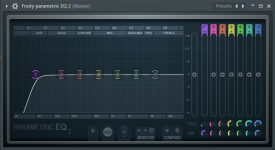
But it has to be that high. around 50hz.
Lower frequencies just make popping sounds, canceling higher lows... like cone would "loose itself", resonate.
I had tryed this with "Ice Mc- Think about the way"... because it has very specific bass, that I know sounds rather dirty on alot of systems.
Another thing I will try is moving HPF back to 30hz and just lower 30hz- 50hz a bit. This would require another stage in preamp I believe?
Also is this a slope I could expect with 4th order Sallen-Key filter, or would the slope be more gradual?
This would help alot. Like you suggested:

But it has to be that high. around 50hz.
Lower frequencies just make popping sounds, canceling higher lows... like cone would "loose itself", resonate.
I had tryed this with "Ice Mc- Think about the way"... because it has very specific bass, that I know sounds rather dirty on alot of systems.
Another thing I will try is moving HPF back to 30hz and just lower 30hz- 50hz a bit. This would require another stage in preamp I believe?
Also is this a slope I could expect with 4th order Sallen-Key filter, or would the slope be more gradual?
Last edited:
No this is not it... still same problem with different kind of music... Gigi`D Agostino... high Italo style bassline... popping like crazy.
I took the speaker out to have a better look of what it is doing...
It`s mint, based on the size, this should give some bass... in enclosed cabinet...
Cone is not soft.
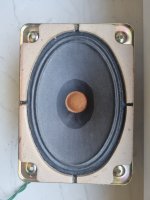
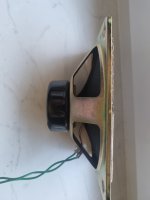
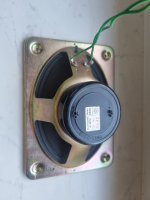
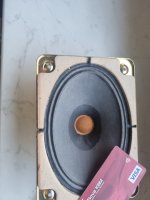
EDIT: Yeah, it`s the speaker, I can hear rattling coming out of it when bass boosted. Nothing seems loose, but will triple check carefuly.
I took the speaker out to have a better look of what it is doing...
It`s mint, based on the size, this should give some bass... in enclosed cabinet...
Cone is not soft.




EDIT: Yeah, it`s the speaker, I can hear rattling coming out of it when bass boosted. Nothing seems loose, but will triple check carefuly.
Last edited:
- Home
- Amplifiers
- Solid State
- Amplifier suggestion for old 3w speaker
